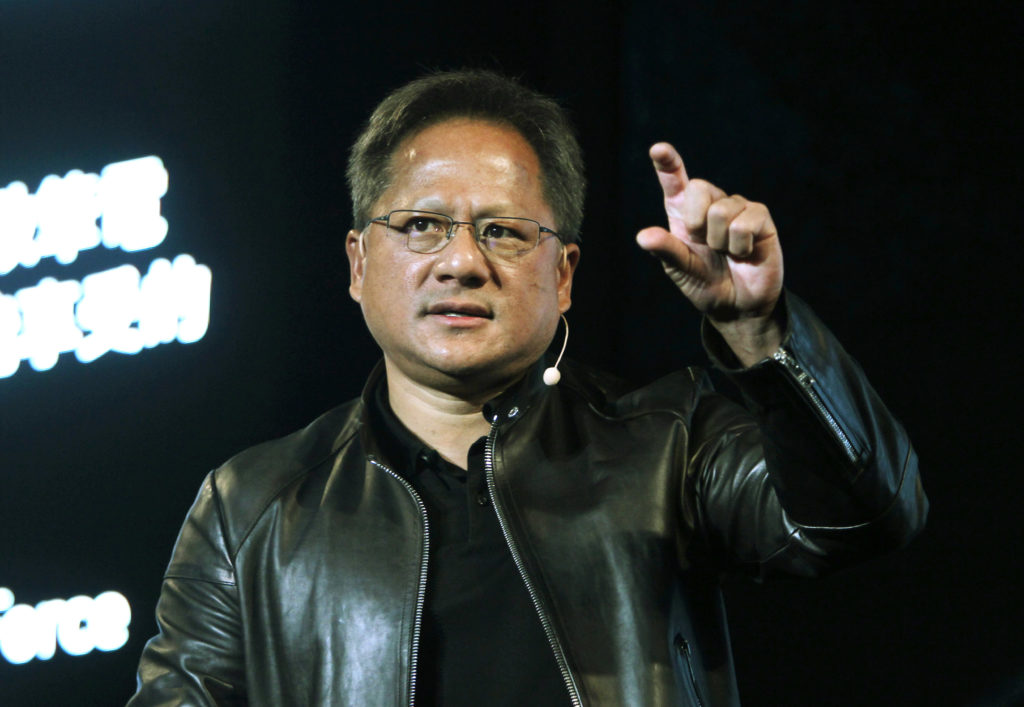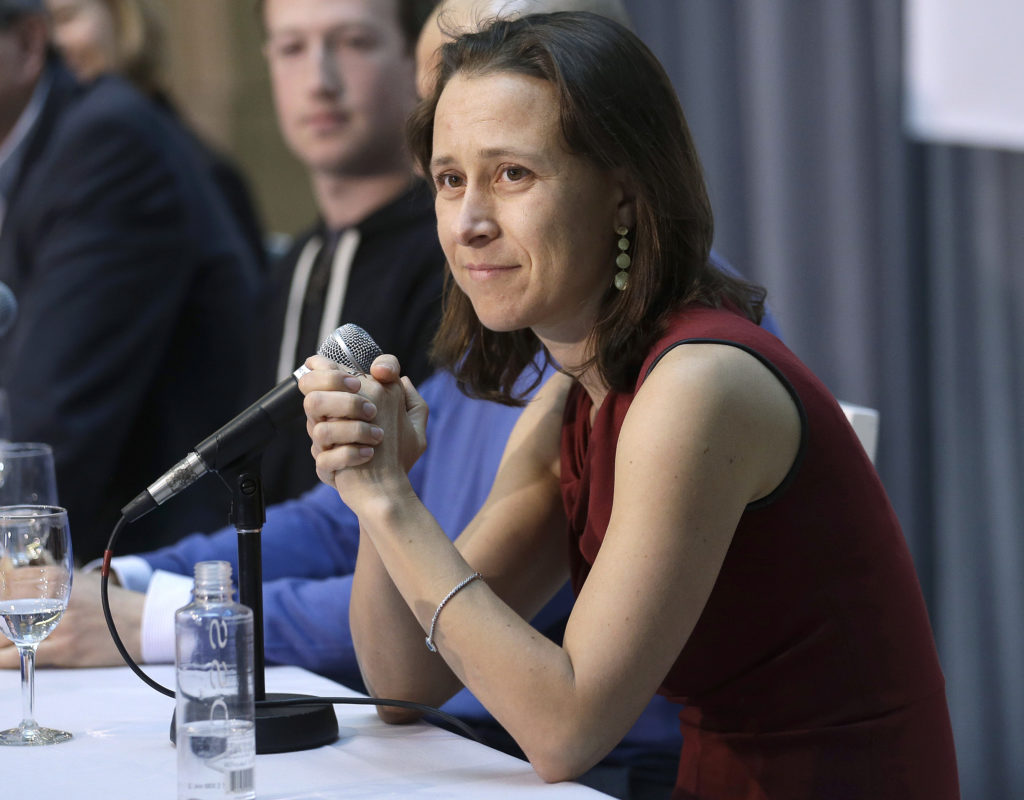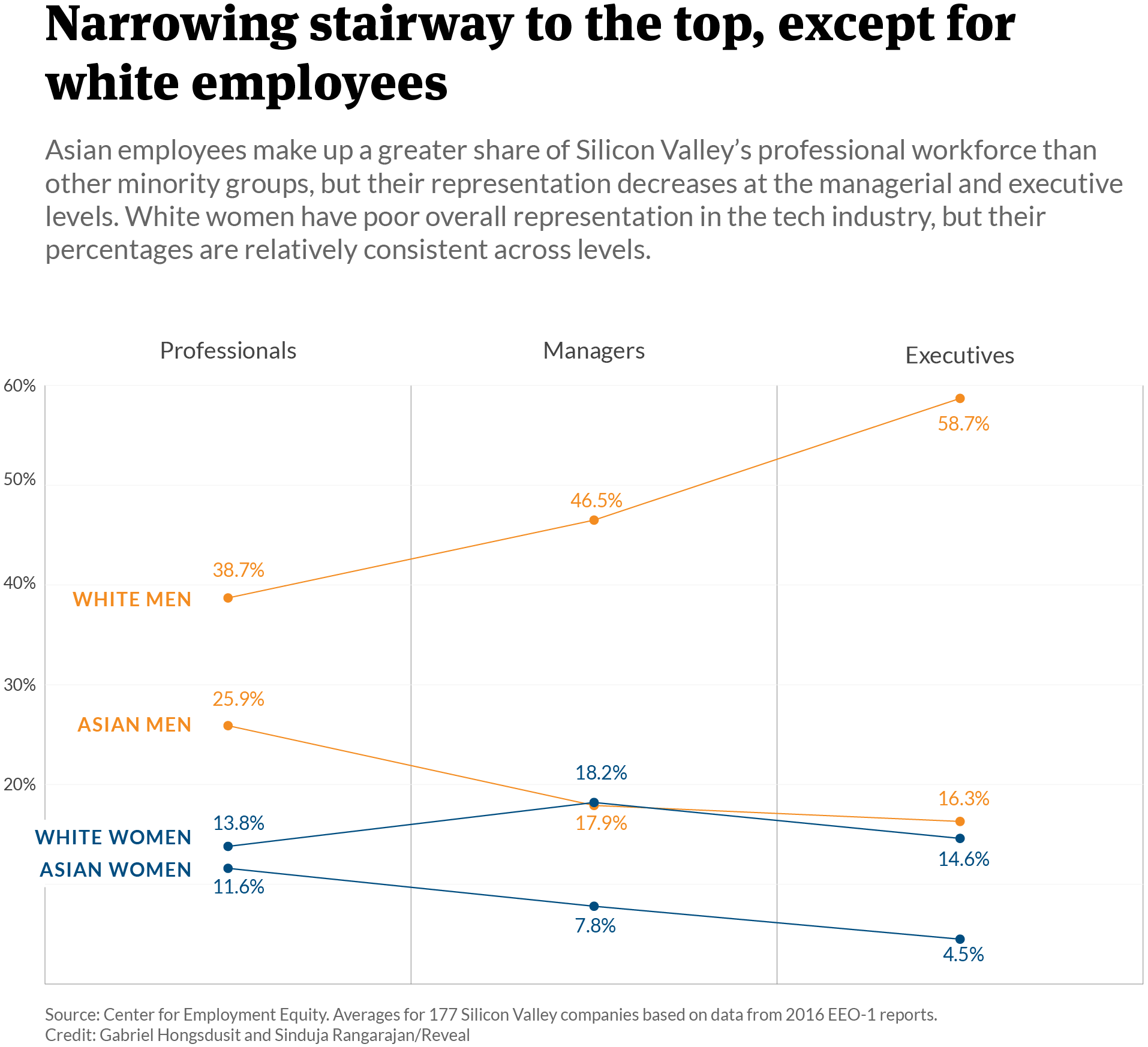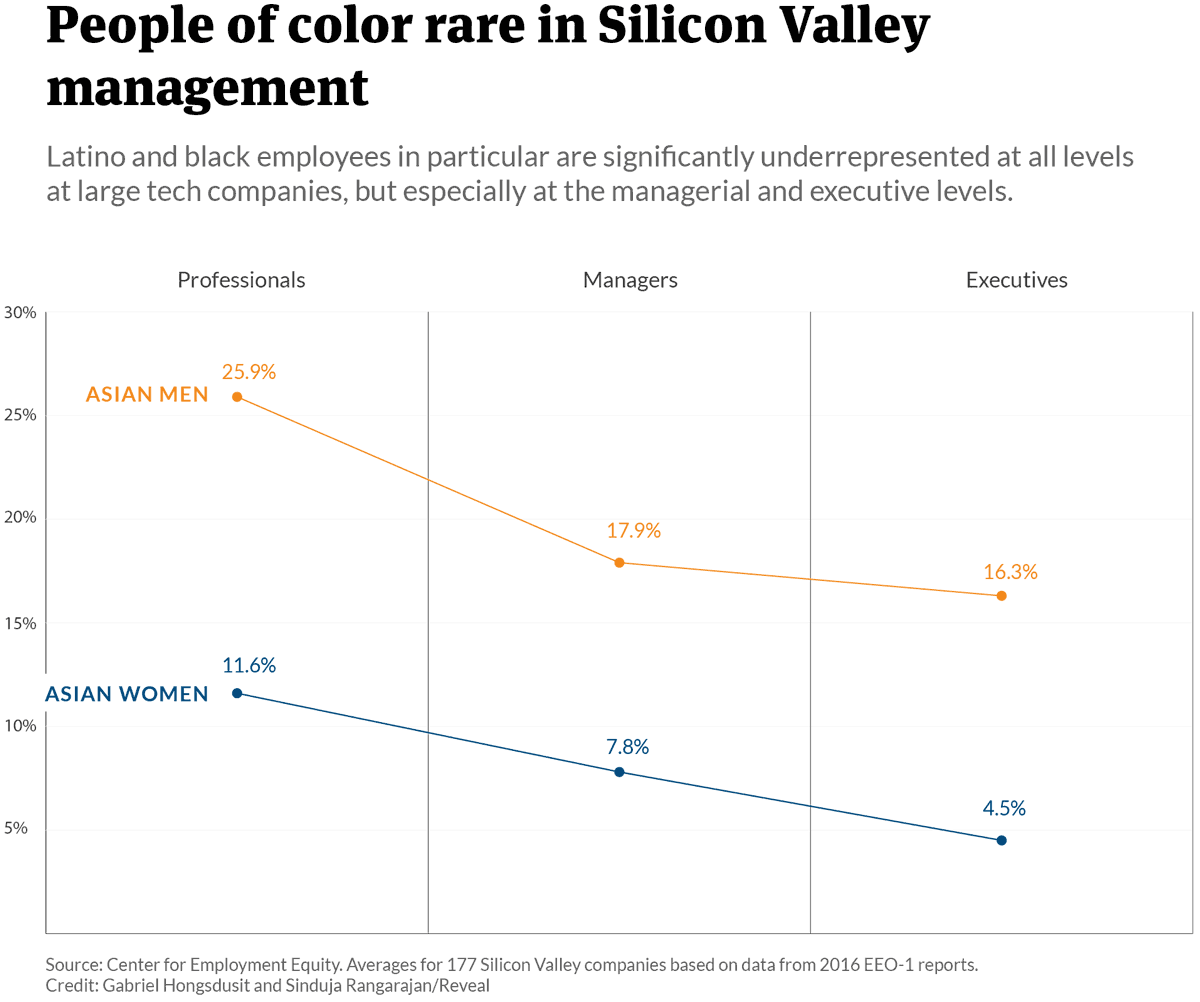This story was produced by Reveal from The Center for Investigative Reporting (link organization name to revealnews.org), a nonprofit news organization. Get their investigations emailed to you directly by signing up at revealnews.org/newsletter.
Ten large technology companies in Silicon Valley did not employ a single black woman in 2016. Three had no black employees at all. Six did not have a single female executive.
In stark contrast, women outnumbered men in the executive ranks of two Silicon Valley companies, and at another firm, nearly a third of executives were women of color.
A first-of-its kind analysis of 177 of the largest San Francisco Bay Area tech firms by Reveal from The Center for Investigative Reporting found that while racial and gender disparities are grave, many companies haven’t been held back by conventional excuses.
Prominent tech companies often say they are trying to improve, but hiring diverse staff is difficult. Facebook has blamed a lack of qualified minority candidates.
“It has become clear that at the most fundamental level, appropriate representation in technology or any other industry will depend upon more people having the opportunity to gain necessary skills through the public education system,” its chief diversity officer, Maxine Williams, wrote in 2016.
For that same year, Reveal’s data shows that a majority of large tech companies headquartered in Silicon Valley – 91 of them – had a higher percentage of black, Latino and multiracial employees among their ranks of executives, managers and professionals than Facebook. That included powerhouses such as Intel and the two firms that used to make up Hewlett-Packard: HP Inc. and Hewlett Packard Enterprise.
Facebook spokesman Anthony Harrison said the company has recruited students of color with specialized training programs, including an engineer-in-residence program at historically black colleges and Hispanic-serving institutions.
“We understand we need to create real training opportunities for students that build on their academic experience,” Harrison said in an email.
Facebook is among a handful of firms that have erred on the side of transparency by routinely releasing diversity data. Identifying other tech leaders and stragglers is difficult – even though the numbers are reported to the government annually.
The U.S. Equal Employment Opportunity commission collects data on race, gender and job category for every company in the United States with more than 100 employees, but it keeps the information confidential.
Last fall, Reveal asked the largest tech companies based in Silicon Valley to share their one-page, federally mandated forms, known as EEO-1 reports.
After Reveal’s initial report, Slack and PayPal released their EEO-1 reports for the first time. Reveal obtained forms from electronics manufacturer Sanmina and data services firm NetApp through Freedom of Information Act requests. Besides Facebook, some other tech giants – including Google, Apple and Intel – regularly publish theirs.
In all, the data is public for only 26 firms for 2016.
But a collaboration between Reveal and the Center for Employment Equityat the University of Massachusetts Amherst offers the most detailed picture ever of the entire field and allows those that are public to be compared with all their peers. The equity center, after a confidentiality review by the Equal Employment Opportunity Commission, provided Reveal with anonymized statistics for 177 companies. Reveal and the equity center then independently analyzed the data.
When it comes to diversity, companies often want to shift responsibility to others, according to Donald Tomaskovic-Devey, a sociology professor at the University of Massachusetts Amherst’s Center for Employment Equity.
“This is not something they do for any other part of the production process,” he said.
Disparities particularly stark at leadership level
Nearly a third of the firms in Reveal’s analysis, including two that have made their statistics public – Lyft and Square – had no executives who were women of color.
And the number of black executives is so low that having any at all catapulted companies to the top of the rankings. Three of 36 executives at NetApp were black, for instance, but that’s 8 percent, making it the second highest among large tech firms. Adobe Systems, a larger company, had almost three times the number of executives of NetApp, but none were black in 2016, according to its EEO-1 report.
Among companies that shared their data publicly, only Facebook had more than 10 black executives.
Nvidia ranked in the bottom four of the 177 large tech companies for gender representation. The venerable chipmaker – whose stock price has increased more than tenfold in the last three years with its advances in artificial intelligence, cryptocurrency, self-driving cars and virtual reality – had a lower percentage of women than its direct competitor, Intel. Nvidia’s workforce was 17 percent women, while Intel’s was 26 percent. Reached by email, Nvidia declined multiple requests to discuss its record.

NVIDIA CEO Jen-Hsun Huang delivers a speech about AI and gaming during the Computex Taipei exhibition at the world trade center in Taipei, Taiwan, Tuesday, May 30, 2017. (AP Photo/Chiang Ying-ying)
Three companies had even lower representation of women than Nvidia, however, including the smart-glass manufacturer View. The other two are among those that keep their diversity statistics anonymous.
And while both Nvidia and online retail giant eBay had a high proportion of Asian professionals, such as analysts, designers and engineers, they employed among the lowest percentages of black, Latino and multiracial professionals.
A gradual cultural shift
Genetic testing company 23andMe had one of the highest percentages of female executives, ranking third.
The Mountain View-based company joined PayPal, Airbnb and financial services software firm Intuit in employing large numbers of women as executives and managers – more than 40 percent, far higher than the average of 28 percent at large tech companies.
At the helm of 23andMe is one of Silicon Valley’s few female CEOs, Anne Wojcicki. Having a female co-founder and CEO has been helpful, said Mark Lipscomb, the company’s vice president of people.

Anne Wojcicki, CEO of genetic testing company 23andMe, is one of the few women at the helm of a large Silicon Valley tech company. Credit: Jeff Chiu/Associated Press
“Other companies that I have come from have coined diversity as an ‘initiative,’” he said. “Here, diversity is not really an initiative. It’s more embedded in our culture. It’s an attitude driven by Anne and permeates to the executive team and rest of the company.”
In addition to leading among black executives, NetApp also was among the leaders for women of color in executive roles, ranking sixth.
But even some of the most diverse companies have work to do.
View, a billion-dollar company, had the second-highest share of black workers, but none were executives. And it ranked second to last for women. A spokesman said that the company’s numbers have improved over time.
“While we’re encouraged to see the numbers of women at View improve year over year, we’re continuing to invest in recruiting efforts to attract more,” said Cameron Craig, View’s head of global corporate communications. “We see diversity as a key competitive advantage that fuels innovation.”
And all of 23andMe’s executives were either white or Asian in 2016, according to its EEO-1 reports. Lipscomb acknowledged this shortcoming and said the company is working to develop diverse talent for leadership roles.
There’s been a gradual cultural shift toward seeing diversity as an important value that not only adds to the bottom line, but also is a moral responsibility, said Katherine Emerson, a researcher at Mills College in Oakland who studies corporate diversity.
Diversity has been a frequent topic of research interest in the past decade, she added. The difference today, she said, “is that people are listening.”
Airbnb laid out a plan in 2016 to recruit more female data scientists.
Google, in an effort to be more transparent, released its own 2018 diversity report with attrition data for the first time. The report acknowledged that even though it was hiring more black workers, it also was losing them at a higher rate than other groups.
Pinterest announced its diversity goals publicly in 2015 and followed that up with reports on progress and failures. It had the highest share of managers who were women of color among the named companies in Reveal’s analysis.
The company’s CEO, Ben Silbermann, sets the tone for what diversity should look like at the company, said Ken Coleman, an industry veteran who serves as an adviser to the company.
“The tone at the top matters a lot,” Coleman said. “The leader of the organization has to be clear and vocal about their commitment to diversity.”
Most companies keep data secret
Getting reliable diversity data from tech companies has been an uphill climb not just for journalists, but also for tech employees and civil rights advocates.
The Rev. Jesse Jackson, who has been at the forefront of advocating for data transparency and accountability initiatives at tech companies, criticized the numbers for black and Latino workers for remaining low several years after companies made public commitments.
“These are the greatest planners in the world,” he said. “They plan global markets. They plan technologies. They have not planned inclusion.”
Strangely, some of the companies doing the best choose to remain anonymous. One company reported that a third of its executives are from underrepresented minority groups. Another company – it could even be the same one because its identity also is hidden – said 82 percent of its executives and managers were women.
Despite having one of the more diverse executive rungs in the industry, NetApp opposed a shareholder resolution to release its data. It refused to give the information to Reveal directly, too, but didn’t object to its release by the government when we filed a FOIA request with the Labor Department for its 2016 data.
NetApp, Facebook and other tech companies say EEO-1 reports don’t accurately reflect how they think about their workforces. The EEO-1 is a snapshot in time and doesn’t include all of NetApp’s employees because the form covers only the U.S., according to Barbara Hardy, the company’s global head of diversity, inclusion and belonging.
Nonetheless, NetApp earlier this year released its 2017 EEO-1 form on its website.
“We were just like, ‘Here, take a look at our EEO-1. We have work to do just like everybody else,’ ” Hardy said.
Other federal contractors such as Palantir Technologies, Oracle and Pandora Media opposed the release of their data, calling it a trade secret, and the Labor Department obliged.
In April, Reveal filed a federal lawsuit alleging that the government violated the Freedom of Information Act by withholding companies’ EEO-1s. That lawsuit is pending.
White men dominate executive ranks
If career paths were staircases, the stairway leading women of color to the top narrows as it rises. For white men, it widens.
Reveal’s data shows that the share of women of color drops higher up at large tech companies. Among professionals – engineers, designers and analysts, for example – 12 percent were Asian women in 2016, but 8 percent of managers and 4.5 percent of executives were Asian women.
The reverse is true for white men, who accounted for about 39 percent of professionals, 47 percent of managers and 59 percent of executives. The share of white women across job levels remained relatively consistent.
Many factors contribute to this trend, including the hostilities that some women say they face every step of the way while working in tech.

According to a 2017 study by the Kapor Center for Social Impact, a think tank, women and other underrepresented groups are more likely to experience unfair treatment, stereotyping and bullying in tech workplaces, and these experiences directly drive turnover.
June Manley, co-founder of Female Founders Faster Forward, a nonprofit that helps female entrepreneurs raise venture capital funding, said she felt disrespected while interviewing for a leadership position last year at VMware, a large cloud computing software company.
Manley said her interviewer, a senior vice president, told her that she shouldn’t expect to join his team as a vice president because he “prefers a flat organization.” At the time, Manley had founded a tech company of her own and had 17 years of experience working in tech, including in high-profile roles at firms such as HP and Citrix.
After the interview, Manley said one of the male vice president’s subordinates told her that she shouldn’t join the company if she wanted to work as a vice president on that team, because it was unlikely she’d get promoted once she was on board. The company was an “old boys’ club,” the employee advised.
VMware doesn’t release its EEO-1s publicly. In the 2015 report obtained by Reveal through FOIA, the company had 20 percent female executives, about the average for large Silicon Valley tech firms. Reveal has requested the company’s 2016 form through FOIA.
Manley wrote an email to company executives highlighting the incident. VMware spokesman Michael Thacker said the company took her feedback seriously.
“Growing and advancing women’s leadership and representation will remain a key focus area for investment and a business priority at VMware,” Thacker said in a statement.
Missed opportunities for women of color
Even when women and minorities get through the door, companies aren’t doing enough to help them grow into leaders, said Karla Monterroso, chief executive officer of Code2040, a nonprofit that focuses on developing black and Latino talent in tech.
Shanea King-Roberson, who is black, joined Google in 2013 as a contractor answering user questions on company forums. She later was hired as a full-time program manager on different teams, including Google Assistant.

Shanea King-Roberson was a program manager at Google. But a manager told her that she probably wouldn’t pass Google’s official tests when she tried to move into a higher-profile position for a product manager. She left and is now a senior technical product manager at eBay.
Credit: Sinduja Rangarajan/Reveal
When a higher-profile position for a product manager opened up four years later, she said Google’s bureaucratic processes made it difficult to switch paths, especially for non-engineers such as her.
She had domain knowledge, some technical expertise and experience doing everything a product manager would do. She had created product roadmaps, set metrics and planned strategy, but, she said, that was not enough.
After interviews with five people on the team she wanted to join and positive verbal feedback, King-Roberson said the team manager pulled her aside and told her that she probably wouldn’t pass Google’s official tests.
She said the manager told her that the tests were hard and that her lack of a computer science degree or years of software engineering experience was an obstacle.
“I would rather have the actual title of having product manager for two years plus a CS degree so I can go and do whatever I want to do, rather than what Google tells me that I can or cannot do,” she said. “So I left.”
King-Roberson already had started pursuing a bachelor’s degree in computer science to add to her degree in business and expects to graduate this summer. After leaving Google, she soon was hired as a senior technical product manager at eBay, where she works on machine learning products.
She acknowledged that the role of a product manager at Google is a coveted position and having a technical degree would have helped, but she also thinks she could have done the job if given the opportunity.
“I think I would have been just fine,” to be honest, she said. “And I say that objectively because I am doing it now.”
A computer science degree is not a requirement to be a product manager at Google, a spokeswoman for the company said via email: “There are a variety of skills we look for in PM candidates, and technical ability and experience is only one of the areas we evaluate and a degree is just one way to capture that.”
Google did not directly answer questions about whether an emphasis on technical abilities keeps women and minorities from advancing at the company.
Serena Cheng left Google in 2014 after working there for three years as a business product manager. She said the company’s everyday culture was informal and valued innovation through collaboration. But the company’s processes often rewarded engineering experience over other skills in roles such as product management.
And more often than not, women – and particularly women of color – didn’t neatly fit into the boxes that hiring managers look for, Cheng said, and companies lose out on the value they can bring.

Some tech companies have a process to bring in people from nontraditional backgrounds, said Carissa Romero, a partner at Paradigm, a consulting firm that advises companies on how to create a diverse and inclusive workforce. Pinterest has an apprenticeship program to allow people without a degree in computer science to enter the tech industry and help them grow in their company.
Sharla Alegria, an assistant professor of sociology at the University of California, Merced, studies racial and gender inequities in tech. She interviewed dozens of tech workers for one study and found that women of color struggled to switch teams or change career tracks within their companies.
She found that white women in technical roles were offered opportunities to become managers in which they could use their communication skills to translate between technical teams and management – even if the women weren’t actively seeking those jobs.
As part of her research, Alegria met a 21-year-old white woman who was still in school and interviewing for her first job out of college as an engineer. The interviewers asked her if she’d like to be a manager instead because of her communication skills.
“They tried to give her a role of a team lead or project manager instead of an engineer because she was particularly gregarious, even though she had no experience in management,” Alegria said. She “had a degree in computer science and was barely qualified for this engineering position that she was trying to get.”
Those same promotions weren’t offered to the women of color in Alegria’s study.
“Every woman of color I interviewed was in a position that she had exactly the skills and credentials for,” she said. “There was none of this ‘oh you have these fantastic communication skills; this job is really good for you.’”
When white women move into managerial roles, some say they feel like it’s a step down from the social status of being an engineer, Alegria found. But they at least had options to move to other roles that offered more flexibility and an escape from male-dominated engineering teams.
Women of color didn’t get those opportunities, she said, so they’d be more likely to leave tech.
Women, minorities overrepresented in support jobs
Even in some companies with more diverse workforces, women and minorities – especially black workers – were overrepresented in support positions such as administrative assistants, customer service and retail.
Facebook, for instance, had 21 times as many women as men in its administrative support jobs in 2016, a proportion much higher than most other companies that have released their numbers. At the executive level, it was two and half times as many men, according to its EEO-1 report.
More than half of Apple’s Latino and black employees worked in retail or administrative support.
Lyft had a higher representation of black workers across job levels compared with its peers. But still, 70 percent of its black employees worked in administrative support.
The distribution of a company’s workforce – who’s working and in which positions – sends signals to minority groups, said Katherine Emerson, the Mills College researcher.
“Am I welcome at the top and they just haven’t found anybody to be up there first? Or is it that people like me are going to be relegated to lower-level positions?” she said. “And that experience for women and for people of color is so exhausting and so stressful.”
Angelica Coleman, who is black, worked as an executive assistant supporting engineering teams at the online file storage company Dropbox. She said she learned to code from her colleagues and friends and had a verbal offer to move onto a design team at the company. But, she said, her boss blocked the move.
Coleman wrote in a Facebook post at the time that another “white manager sat me down, looked me in the eye and told me, ‘If you ever want to be anything other than an admin, you need to go somewhere else.’ ”
Dropbox did not respond to Reveal for this story and is one of the companies that hasn’t released its EEO-1 report.
After leaving Dropbox in 2015, Coleman was able to move up. She worked at Zendesk, a software company, as a developer relations manager, supporting the platform’s third-party developers and doing some programming. She currently works as a community director at the nonprofit Lesbians Who Tech.
Companies should create pathways for people in support roles to move up the ladder through training and mentorship, Code2040’s Monterroso said.
“In the previous generations, folks who were working in the mailroom at Kodak would all of a sudden become the manager of an entire region because they worked themselves up little by little,” she said. “That is not the life that current entry-level and working-class people have.”
Is there a pipeline problem?
Studies repeatedly have exposed a gap between the percentage of black and Latino computer science graduates in the country and the percentage of black and Latino engineers in Silicon Valley.
“Usually companies feel like it’s more of a pipeline problem, but often, the pipeline has more diversity than the current employee population,” said Romero, the Paradigm diversity consultant. “And that’s particularly true when you look at race and ethnicity.”
Tech companies care too much about pedigree and schools, Monterroso said.
“Stanford is not a skill. MIT is not a skill. Harvard is not a skill,” she said. “They have yet to identify the skills that are disproportionately coming from those universities that make them top-tier talent.”
In addition, minorities hold a far higher percentage of tech jobs outside the tech sector, suggesting that there may be more workers available than the current narrow pool from which tech companies recruit.
A recent Government Accountability Office report estimated that 8 percent of professionals at companies such as banks, universities and hospitals were black, including employees in technical roles. Meanwhile, 4 percent of all professionals in leading tech companies were black, according to the report.
“If there is a pipeline problem here,” said Donald Tomaskovic-Devey, the University of Massachusetts Amherst professor, “it may simply be the failure to build the pipe.”